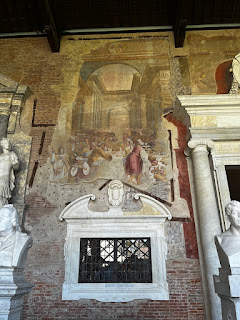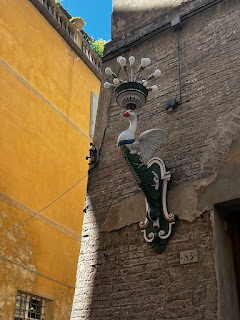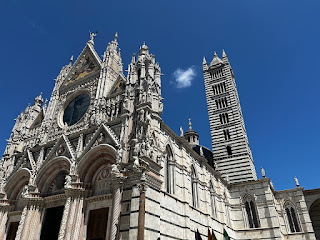Today’s adventure began with a trip to the famous city of Pisa. The leaning tower seems to be on everyone’s travel list, so it shouldn't be too surprising that it was included in our Tuscany tour. We headed out early, by bus, to the outskirts of the town. Here we all hopped into a travel train that escorted us on a very rickety and bumpy trip near the entrance to the Piazza.
We met our guide, Vincenzo, who did an excellent job instructing us on how to get the best photo. He even included a hint on just how to capture an image where it appeared that someone was trying to hold up the bell tower. Looks like his instructions were spot on!
Our fellow traveler, Andrew, took the perfect photo of us standing in front. He certainly does capture a great image, doesn't he?
Along the back of the tower is the Baptistry.
And if you look closely, you can see St. John the Baptist on the top.
Vincenzo had SO many interesting facts to share with us! The Romanesque Cathedral was founded in 1064, but it wasn't finished until the late 12th century.
Only the finest materials were used in its construction, not for religious reasons, but for a political motive. Pisa was a port city, and as such, wanted to maintain a financial interest. It was believed that the opulence of the church and the surrounding structures would attract visitors from afar, who would be eager to set up trade, thereby making it a very prosperous city.
We learned that a large Jewish community lived here, and all were welcomed in Pisa. There was not a "jewish ghetto" locked at night as was the case in most other nearby cities. In addition, the Jewish cemetery is located behind a brick wall, just on the edge of the Piazza where the Duomo stands, not far from the Baptistry. Vincenzo was certain to point it out to us while we stood admiring the beauty of the construction. He also mentioned that this type of acceptance by the community was unusual in this area of Italy.
Just to the left of the Duomo, a long structure stands adjacent that is filled with amazing artwork going back centuries in time. On the roof stands this 3D design.
Once inside, one cannot not miss the full sized Frescoes from the 13th century that adorn the walls. Upon first look, I had thought that the colors had faded due to exposure and age. However, Vincenzo informed us that a German artillery shell hit the roof of this building on July 6, 1944, resulting in an inferno that lasted three days. It destroyed much of the artwork in addition to many of the sarcophagus burials in the floor of the building.
Many of the paintings lost their brilliant colors, but they have been painstakingly undergoing renovations for many years.
Vincenzo pointed out this fresco of the universe painted in the 14th century by Pietro di Puccio da Orvieto. Earth is at its center with numerous concentric circles emanating outwards. The signs of the Zodiac can be seen on larger ring, towards the middle of the fresco, that is dark brown in color.
On the lower left sits St. Augustine, and on the lower right stands St. Thomas Aquinas. At the top is the almighty creator, holding the sphere in his hands. So much symbolism, and an amazing amount of detail, don't you think? I appreciated Vincenzo taking the time to point out certain features of these frescoes, with an explanation so that we could better understand just what we were admiring.
The frescoes line the exterior walls of this rectangular wing of the Duomo. Nearly back to where we entered, this fresco was painted in the late 1300s by Buonamico Buffalmacco. It is part of a panel, with Just a quick synopsis: Jesus and his mother are sitting in the oval rings at the top with angels blowing trumpets beneath them. As you can well imagine, there is a wealth of symbolism in this fresco, and it is an interesting perspective into the mindset of painters and their intended audience during that time period.
Preservationists are fortunate to have been able to reveal some of the original beauty, although much of the brilliance will be forever lost due to the unfortunate destruction.
Having gone full circle through the camposanto, we walked along the lawn to the entrance to the Duomo. Upon entering the doors, we were greeted with a brilliant interior. Looking up, I admired the wooden ceiling that is painted and highlighted in gold leaf. Vincenzo mentioned that Eighty one kilos of gold was used in the enhancement.
Much to my surprise, we learned that this church holds yet another incorruptible, Saint Renaldi. (That's three for this trip) His body lays at the base of a special altar to the right of the main altar. I passed on photographing it.
After viewing the special memorial to the saint, we turned and walked to the middle of the church to admire the main altar.
An ornately carved pulpit stands along the left hand side, depicting scenes from the Bible.
It was created by Giovanni Pisano and completed in 1310. Unfortunately, a fire broke out in the cathedral, and although this famous piece survived, it was dismantled until 1926 when it was reassembled and placed in the location where it now stands.
Vincenzo had explained prior to our entering the cathedral, that artists in the original time period, used this type of medium to visually explain the scriptures as most people did not read. The top panels are sculpted with episodes of the life of Christ, including the Nativity and the Adoration of the Shepherds.
Pillars in the back represent the four Cardinal virtues.
But you might be wondering why the front pillars are not carved. Vincenzo explained that these were donated by Mussolini to replace damaged pillars, and thereby placed in plain view (rather than in the back), so the populace would know that he was responsible for the restoration. The surviving, ornately carved pillars can be seen towards the back, but with all of the scaffolding surrounding it (due to a new restoration project), we had to be satisfied with this view.
At this point, our tour was over, and we were granted free time to get out and explore Pisa. It's not very large, so we headed to a cafe and enjoyed a caprese salad for lunch. It was delicious....light and refreshing and flavorful.
We then headed to the local Gelateria, where I enjoyed a dark chocolate and nutella gelato. Perfect for a warm day and absolutely delectable!
Marty wanted a few more photos prior to our leaving, so here we are:
It appears that the bell tower can't make up its mind as to whether or not it is leaning.
And, in this photo below, I was amused by the tree on the right, which actually leans at just about the same pitch as the tower.
By now it was time to leave this famous city, so we once again boarded the little train to lead us back to the bus. My advice: don't sit in the back seat! It reminded me of a wooden amusement ride from when I was a kid. Every bump had me flying up off my seat. Fun for a kid.....a challenge for me!
We were back at our hotel by 3:00 and had just about an hour to relax before heading out, again, to a local farm where we could try our hand at cooking a typical Italian meal.
The setting was ideal.
A quick tour of the farm revealed some happy chickens
lovely floral gardens
lemons.....lots of them!
tomatoes
and several varieties of herbs
as well as white and red grapes.
It was easy to see how this farm could make claim to using all local ingredients in their food.
We were led to an outdoor, covered area, where, within short time, we were set to chopping tomatoes for Bruschetta as well as potatoes, carrots, zucchini, cabbage and onions for a Tuscan soup.
We were then given pasta dough to press through a machine to make tagliatelle.
And, as an extra treat, were given a ball of dough to roll into a tube for biscotti for dessert.
As our food was cooking, we were led into a large room with set tables, for us to sit, relax, enjoy some wine and charcuterie and wait for the results of our hard work.
And, there were some extra courses thrown in there as well. It seems that Italians have a LOT of courses when they eat dinner. Not that I'm complaining.
The hosts were definitely entertaining, the food was excellent, and the conversations were quite lively.
Filled with food and vino, we all managed to make our way to the bus for the short ride back to the hotel.
Our guide, JoAnn, had Italian music playing on our ride for us to sing along to. And we joined voices to sing Volare and That's Amore, probably the only two Italian like songs that we know!
I can't speak for everyone, but I can attest to the fact that those of us in the back of the bus were having a grand time!
Now...off to bed. We have an early morning!
Until next time....
































































